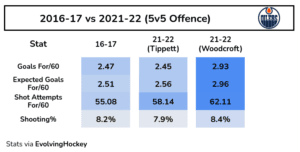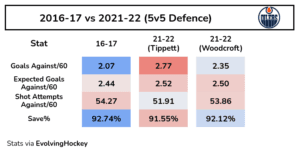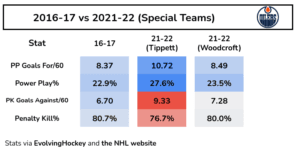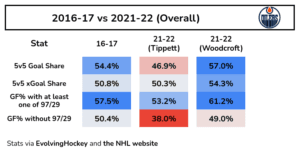Nation Sites
The Nation Network
OilersNation has no direct affiliation to the Edmonton Oilers, Oilers Entertainment Group, NHL, or NHLPA
How well do the 2021-22 Edmonton Oilers rank in comparison to the 2016-17 Oilers?

Photo credit: https://twitter.com/EdmontonOilers
In the past 15 years, it’s evident that the Edmonton Oilers have experienced minimal playoff success. The closest they’ve come to a deep playoff run (so far) was in the season of 2016-17.
That year, Todd McLellan and the Edmonton Oilers finished with a record of 47-26-9 and 103 points, as they ranked 2nd in the Pacific Division, just behind the Anaheim Ducks. It was the season that Edmonton finally broke a 10-year drought of missing the playoffs.
They won in six games against the San Jose Sharks in the first round, but lost to the Anaheim Ducks in a heartbreaking seven-game series in the second round. Many should recall some brutal reffing in that series, especially the incident with Ryan Kesler in Game 5 (although it’s worth mentioning that Anaheim was still the superior team in regards to CF% and xGF% that series).
This year, it’s been a season of drastic ups and downs, as Edmonton began the year with a 16-5 record, but followed it up with a dreadful record of 7-14-3 that ended in the departures of Dave Tippett and Jim Playfair.
Ever since the arrivals of Jay Woodcroft and Dave Manson, Edmonton’s performance has significantly improved, as Woodcroft’s Oilers hold a record of 23-8-3. Last night, with a win over the Colorado Avalanche, Edmonton officially clinched a playoff spot.
So, how does Edmonton’s current roster compare to their roster in 16-17? Which team is superior offensively and defensively? What advantages does the current roster have over the 16-17 Oilers, and what key components are they missing from that squad?
*All stats via EvolvingHockey, Natural Stat Trick and PuckIQ unless stated otherwise
5v5 Offence

Tippett’s Oilers and the 16-17 Oilers are essentially identical in regards to generating goals and expected goals, although Tippett’s Oilers took an excessive rate of low-quality point-shots, as I explained in one of my former pieces. Comparatively, the team in 16-17 put more emphasis on quality shots, and they marginally generated more 5v5 goals, so I would give the slight edge to them in this facet.
However, Woodcroft’s Oilers possess the more significant advantage here, as they’re considerably superior in regards to generating goals, and both shot quality and quantity. Their neutral zone play has been superb, and Edmonton has a much more aggressive forecheck structure under Woodcroft. Ever since Woodcroft’s hiring, only Florida and Carolina have a superior 5v5 xGF/60.
This season, Edmonton has scored at a rate of 3.16 goals per hour with at least one of McDavid or Draisaitl on-ice. With both of them off-ice, they score at a rate of 2.12.
Meanwhile, in 2016-17, Edmonton scored 3.17 goals per hour with at least one of McDavid or Draisaitl on-ice, while they scored at a rate of 1.91 with both of them off-ice.
It’s somewhat difficult to comprehend after the bottom six’s dreadful start, but Edmonton’s superior offence is largely due to increased forward depth. The vast majority of the offensive success of Edmonton’s bottom-six is due to Woodcroft, as the goal differential of the bottom-six increased by roughly 11-12% since Dave Tippett’s firing. The bottom-six without Josh Archibald on-ice is actually a positive in terms of goal differential (the bottom-six under Woodcroft has scored 25 goals, and allowed 26 against. The bottom-six without Archibald has scored 24 goals, and allowed 22 against).
Diving deeper into individual players, it’s quite evident that Leon Draisaitl has considerably improved from 16-17. That season, he held a goal differential of just 44% without McDavid, but this season, Draisaitl has a 55 GF% with McDavid off-ice. Hopefully, this is the end of the narrative that Draisaitl is “a product of McDavid.”
McDavid had a spectacular season in 2016-17, posting solid defensive numbers and dominating offensively. His defensive play in 2021-22 is very similar to 16-17, but I would certainly say that the current McDavid is even more dynamic offensively (although he’s sustained quite a bit of poor luck this season, with a career-low on-ice shooting% of 8.04%). Nugent-Hopkins has also improved from the player he was several years ago.
Edmonton’s top-six winger depth consisted of Milan Lucic, Jordan Eberle, and Patrick Maroon in 16-17.
Eberle and especially Maroon had solid seasons at 5v5. Eberle had a goal differential of 55.8%, an expected goal differential of 51.8% and posted 20 goals and 51 points in 82 GP.
Eberle was poor in the playoffs, but a significant portion of his performance was bad luck; he had an on-ice shooting% of merely 1.22%, and an on-ice SV% of 88.7%. I won’t argue that he was good in any sense at all, but it’s absolutely fair to state that some misfortune and poor luck caused his performance to look worse than it already was. I still believe it was a poor decision by Peter Chiarelli to ship him off.
Maroon was at a 58.3 GF% and 55.6 xGF%, and posted 27 goals and 41 points that season. Of course, a large portion of his success should be attributed to McDavid, but it’s worth mentioning that McDavid posted a superior GF% and xGF% with Maroon on-ice, as opposed to without.
All things considered, I feel that Edmonton’s current winger depth of Puljujarvi, Yamamoto, Hyman, and Kane are superior, and the offensive results display that. Puljujarvi and Hyman are upgrades over Maroon and Eberle, Kane isn’t exceptional at 5v5 but his goal-scoring abilities should give him the edge over Lucic, and Yamamoto is essentially better than any other winger on the 16-17 roster.
5v5 Defence and Goaltending

Neither of these teams is exceptional in regards to suppressing chances and shots against.
Tippett’s Oilers were decent in CA/60, but they were awful in regards to shot quality against, consistently allowing high-danger chances off the rush. Woodcroft’s Oilers have significantly improved in regards to rush chances against, although they still struggle with preventing slot shots against, as noted by Jason Gregor here. Of course, it’s difficult to place a lot of blame on the coaching in this scenario, as the defensive core on paper still has several flaws.
Woodcroft’s Oilers have experienced superior goaltending, leading to superior GA results, but I do feel that their improved defensive structure has played a decent role in the recent improvement of Edmonton’s goaltending.
The 2016-17 roster allows more shot attempts than both Tippett and Woodcroft’s Oilers, but they’re better in xGA, largely due to their superior shot quality against results.
Oscar Klefbom was quite reliable in 16-17. Klefbom posted a GF% of 53%, and an xGF% of 51.2%.
However, per PuckIQ, it was the Andrej Sekera pair that played the most against Elite Competition. Sekera played roughly 35.4% of his TOI against elite QOC, while Klefbom played roughly 34.8% of his TOI against Elite QOC. Not a significant discrepancy, but something worth noting.
Sekera posted a 57 GF%, and 51.8% xGF%, but he was a negative in relative DFF% (DFF% is very similar to xGF%) against elite competition. He posted a relative DFF% of -1.9% against Elite QOC.
Most of his strong results were due to dominant play against weaker competition, while it was somewhat of the opposite for Oscar Klefbom, who played slightly better against top competition with a relative DFF% of +0.4%. Nonetheless, both had strong seasons and were key factors in their regular-season success. Adam Larsson was primarily paired with Klefbom, and posted similar numbers, with a relative DFF% of +0.7% against Elite QOC, and an overall GF% and xGF% of 56% and 52% respectively.
This was a season in which there was quite a lot of debate over the value of Kris Russell. He was also deployed against difficult opposition, but struggled in this role, posting a team-worst relative DFF% of -2.8%. His goal share was quite good, as it was at 54%, but possessed an overall CF% and xGF% of 47% and 48% respectively. He obtained a fair amount of defensive luck that year, with an on-ice SV% of 93.8% that inflated his goal differential. The following season, Russell’s GF% predictably regressed to 44%.
Additionally, Matt Benning was also a fine third-pairing defenceman that year, with a 57 GF% and 52 xGF%. I was always quite fond of Benning in the role he played.
In terms of comparisons, I think Klefbom and Sekera are a much more reliable and well-rounded LD core than Nurse and Keith.
I wrote all about Nurse a few weeks back, but he’s an excellent puck-moving offensive defenceman, but with several flaws in his performance, especially defensively. I also wrote about Keith here; he had a strong start to the season, and he’s usually reliable in his own zone. However, Keith’s skating and foot speed has consistently declined as the season has progressed, and he’s abysmal at defending rush chances.
Courtesy of All Three Zones, Keith’s Chances Allowed on Entries Against/60 ranks in the 6th percentile; in other words, he suppresses chances on entries against at a superior rate than merely 6% of the league. Keith is also poor against top competition, posting a dreadful -8.6% relative DFF% against elite QOC.
As for the RD, Cody Ceci has thrived under Woodcroft, and I’d say 16-17 Larsson and Ceci are pretty close.
Bouchard is undoubtedly superior to Russell. Bouchard does have considerable issues with defending in his own zone, but his offensive skill and talent are undeniable.
Tyson Barrie is also quite poor defensively, but he has excelled in a third-pair role alongside Brett Kulak, although they’ve been quite sheltered, playing merely 11% of their time against top opposition.
Based on their results under Woodcroft, the gap isn’t significant, but I’d give the edge to the 2016-17 team in regards to the defensive core.
The major reason for the considerable advantage in GA/60 for the 16-17 Oilers was their excellent goaltending, almost entirely due to a phenomenal season by Cam Talbot. If it wasn’t for a spectacular season by Sergei Bobrovsky that year, I would argue that Talbot deserved several 1st/2nd place Vezina votes.
Talbot finished the season with a 91.9 SV%, and 2nd in the league in GSAx (Goals Saved Above Expected), as he saved roughly 31.2 goals more than expected to. 2016-17 Talbot was certainly the best performance by any Oilers goaltender in the past 15 years.
As for Edmonton’s current goaltending, it’s a very fascinating situation. Mike Smith had a horrendous start to the season, with an 89.1 SV% in his first 15 games. He allowed roughly 7.6 goals more than expected. However, in his last 11 games, he has a SV% of 93.9%, and has saved 10.5 goals more than expected.
This perfectly reflects who Mike Smith is; a streaky and wildly inconsistent goaltender who frequently goes on stretches with abysmal or excellent play. It seems like there’s very little middle ground in his performance. Hopefully, Smith can sustain and carry his recent performance into the playoffs, but it’s certainly a large risk to place a lot of reliance on him, especially at his current age.
As for Mikko Koskinen, he’s an exceedingly capable backup, but struggles under a difficult workload, and will occasionally have superb and awful games. Neither goalie is immensely reliable, and it’s quite apparent and obvious that the 16-17 Oilers hold the edge in goaltending.
Special Teams

The 2016-17 Oilers and Woodcroft’s Oilers are fairly similar in regards to special teams, with both squads ranking above-average on the power play and penalty kill.
Woodcroft’s Oilers are slightly better on the PP, while the 16-17 Oilers are slightly better on the penalty kill. Dave Tippett’s Oilers were quite high-event in regards to special teams; the power play was excellent, but the penalty kill was abysmal this season.
Neither team has a clear or significant upper hand, in regards to special teams.
Conclusion
Here’s how the 16-17 Oilers rank in regards to overall 5v5 play.

To briefly summarize;
That 2016-17 Oilers weren’t necessarily a formidable cup contender yet, but they were generally a very well-rounded and solid team. McLellan was a flawed coach, who had poor in-game management, seldom called timeouts, and was awful with younger players (notably Puljujarvi), but to his credit, most teams he coaches are generally a positive in CF% and xGF% at 5v5.
Their bottom-six was a positively contributing factor, as their goal share was 50.4%. The most significant advantage this team has over the 2021-22 Oilers is goaltending, and their overall defensive core is somewhat superior as well.
The current Edmonton team was heavily brought down by Dave Tippett and Jim Playfair, and they’ve flourished under Jay Woodcroft and Dave Manson.
It’s interesting to see that the 5v5 goal differential of the bottom-six alone under Woodcroft, is superior to the overall goal differential of Tippett’s Oilers (!!).
The 2016-17 Oilers are better than the current roster when they were under Tippett, but I’d strongly argue that Woodcroft’s Oilers are superior to both. Neither side has a considerable edge in regards to special teams, but Woodcroft’s Oilers have been dominant in regards to goal share, expected goal share, and possession. The current roster is undoubtedly the greater offensive team.
It’ll be interesting to see how much the current team can accomplish in the playoffs. At this point, they’ll likely face the Los Angeles Kings in the first round. LA’s current head coach is McLellan, and at the time, Woodcroft was the assistant coach under McLellan in 16-17. This would be a very fascinating matchup.
Hopefully, the current team can go even deeper into the playoffs than the 2016-17 squad did. The current and recent trend under Woodcroft and Manson is encouraging, but the primary and uncertain question mark this year will be the goaltending.
Find me on Twitter (@NHL_Sid)
Breaking News
- Oilersnation Radio: Oilers trade Stuart Skinner for Tristan Jarry and the boys needed to talk about it
- Canucks trade Quinn Hughes to Wild in conference shaking move
- Flashback Friday: The Stuart Skinner trade is reminiscent of the Devan Dubnyk trade
- Friedman: Oilers ‘poked around’ Sabres goaltender Alex Lyon ahead of Jarry trade
- The Day After 31.0: Lineup continuity has Oilers rolling
